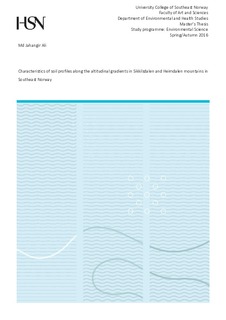| dc.description.abstract | This thesis examines and compares the characteristics of soil profiles along the altitudinal gradients in Sikkilsdalen and Heimdalen, situated in southeast Norway on the basis of primary data collected from the north facing and south facing slopes. To achieve the goal, content of plant available potassium (K), magnesium (Mg), calcium (Ca) and phosphorus (P) were quantified in soil profiles at an interval of 100 m from top to bottom of the mountains. Loss on ignition, pH, particle size and soil types were also examined and described.
Organic carbon (C) were determined by loss on ignition. The plant available nutrients were determined by extracting soil with AL-solution (0.1 M ammonium lactate and 0.4 M acetate). Soil pH of all samples were determined in a soil: water of 1:2.5 (volume based) with the help of pH meter. Dry sieving was performed to determine the particle size distribution (texture) of the soil. Unified soil classification technique was used to determine the soil type on the basis of uniformity coefficient and coefficient of curvature.
Overall, plant available nutrients K, Mg, Ca, organic C is found to be significantly unchanged with respect to the mountain, but, phosphate is significantly different. Soil type is not variate with altitude and slope. Particle sizes D10, D60 were found to be almost same in all profiles, but D30 Varies significantly. Also, pH is not changed too with respect to the mountain, horizon and soil type.
Soils were found acidic in all profiles. Organic C, K, Ca and Mg show negative correlations with pH and altitude. In contrast, phosphate is positive correlated with pH and altitude. Organic C is found to be skewed with respect to the mountains and depths. Its concentration is higher in sand than gravel, and it is declining downward as well. Average potassium contents were high in upper soil and poorly graded sand, and the average estimated content were 10 mg/100 g. Average Phosphate content was 1-2 mg/100 g in north face, and it was 0.5-1 mg/100 g in south face. The content was higher in gravel than sand.
Magnesium content was between 1.4 and 57.1 mg/100 gm, it was high in well graded sand, and not normally distributed. Ca varied between 10.4 and 279.6 mg/100 g and it was reducing with depth. Mg and Ca were also higher in sand than gravel.
Only GG (gap graded), GP (poorly graded gravel), GW (well graded gravel), SP (poorly graded sand) and SW (well graded sand) soil types were found in both mountains on the basis of unified soil classification.
pH shows almost uniform trends along the transects, however, regression lines for nutrients vary between mountains along the altitudinal gradients. | nb_NO |
